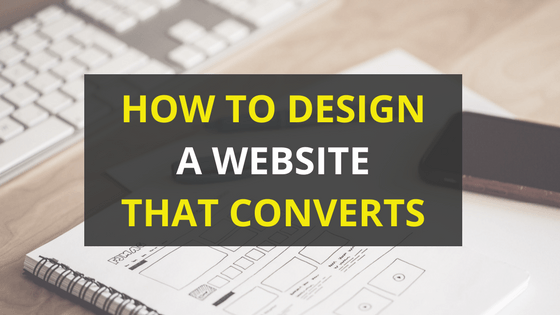October 12, 2015
How to design a website that converts

We live in a fast-paced world, where everyone is busy and nobody seems to have enough time. With everything becoming more accessible and consumers increasingly expecting things ‘now’, it’s no surprise that when it comes to searching online, ten seconds is all the time a business has to convince someone to stay on their website. Ten seconds isn’t long at all (in fact by the time you finish reading this sentence 10 more seconds will have already passed) meaning that it’s crucial that your site is designed with both the user and your conversion goals in mind.
Not only is it about the design of your site in terms of how it looks (although this certainly does come into it), but there are a number of other elements of website design that must be considered when planning a website that will convert well.
Using the AIDA (Attention, Interest, Desire and Action) principles, let’s explore the role that website design plays in driving conversion.
Attention
As mentioned above, you only have ten seconds to grab a user’s attention when they land on your website. First impressions are formed very quickly, and it’s those first 10 seconds that will either lead the user further into the site or turn them away completely. Therefore, the homepage or landing page of a website needs to be eye-catching and engaging enough to convince the user to keep reading.
Interest
Users are only going to stay on a website if they find it interesting. In order to retain a user’s interest, it must be clear to them what value they are getting. It also helps to aim to establish an emotional connection, which can be done when you have a solid understanding of who your target customer is. There is a range of different design strategies that can influence emotional connection, such as strategic use of colour psychology.
Desire
In addition to capturing a user’s attention and sparking their interest, your website should also drive a desire for your product or service. To do this, ensure that your website provides detailed information on what you offer, in a way that is easy to understand and in line with the needs of your target market. People respond better to concise information rather than large blocks of text, which should be reflected in the design of your website. For example, the use of bullets and subheadings, white space and contrasting colours to break up text and help important points to stand out.
Action
Once you have their attention, have sparked their interest and driven them to have a desire for your product or service, you then need to make it as easy as possible for users to take action. Ensure that clear and compelling call to action are located throughout the website so that a user can take action from wherever they are on the site when they make the decision.
How about the actual design characteristics of a website that contribute to driving conversion? Here are 5 key design characteristics that can’t be ignored…
Easy to Navigate
Navigating from one page on a website to another shouldn’t require too much thinking and should feel natural and straightforward for the user. The information on the site will perform better if it is organised logically, considering the target market, what’s important to them and their typical thought process when looking for your product or service. Some best practices in menu navigation include
- Each menu item should be strategically named and must match its contents exactly, making it immediately clear to the user what information they will find by clicking on that menu item.
- The top-level navigation menu should contain no more than eight items to avoid a ‘cluttered’ or ‘crowded’ menu.
- Breadcrumb navigation should be shown on every back page of the site, allowing users to easily retrace their steps and making it easy for them to see where they are within the site.
- A search function will allow visitors to locate the information or product that they are looking for quickly, without having to navigate through multiple pages.
- Consider the use of Mega Menus, particularly if your website is an e-commerce site. Mega Menus allow visitors to get a preview of the product/s without having to go through several pages.
Clear Calls to Action
As mentioned earlier, it must be easy for users to take action on your website. What this action looks like will be highly dependent on your conversion goals (i.e. online purchase, free demo, submit an enquiry, etc.). Clear and compelling call to action prompts should be shown throughout the website, taking into consideration the location within the site and your conversion goals. Below are some tips to ensure your calls to action are effective.
- Use action-oriented text (i.e. ‘Secure Your Reservation’).
- The colour of the call to action should be contrasting to the colour of the background to ensure that it stands out.
- The size of the call to action should be large enough to be noticed but not too large that it becomes off-putting.
- The call to action should be located somewhere eye-catching and in line with typical viewing patterns (users typically view website content in an ‘F’ pattern).
Visual Hierarchy
The content on your website should be organised in a way that prioritises the most important info, ensuring that users don’t miss the key points. There is a science to drawing a user’s attention to the most important information on the page. Some of the principles that guide the positioning of the items on a page include:
- Scanning Patterns – multiple studies have shown that before committing to reading a page, visitors first scan the page in either an F or Z pattern.
- Size – the most important information is highlighted through size and hence makes it difficult to miss.
- White space – when an item or a text is surrounded by a lot of white space, the eye tends to focus on it.
Use of Colours
Colour affects human emotion and behaviour and can be used to influence users to take action. Therefore, having a solid understanding of who your target market is will allow you to choose the colours that will have a positive sway on their emotions.
Readable Text
Reading the content of your website should not be taxing. Use hierarchy to differentiate the level of importance of the content. To prevent your visitors from getting frustrated, easy to read font and easy to understand text must also be used.
People tend to easily become bored with websites and the design of your website has a huge bearing on whether or not they will continue to explore your website and take action. Having said this, it is also highly important to consider website usability best practices when designing your website, ensuring a positive user experience when interacting with your site.
Tags: Conversion Rate Optimisation, Integrated Marketing Communications, Sales Strategy, Strategy, Website Conversions, Website Development

